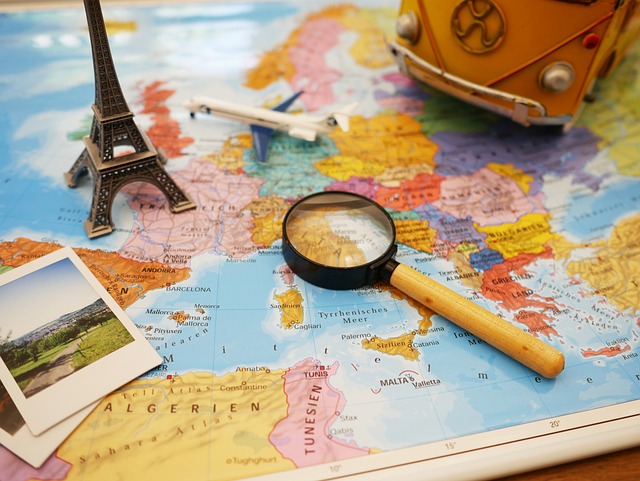Packing efficiently for a trip can make your travel experience smoother and more enjoyable. This blog post provides practical tips and strategies on how to pack effectively for any type of trip, helping to maximize space, minimize stress, and ensure you have everything you need.
1. Understanding the Importance of Efficient Packing
Efficient packing is crucial for a successful and stress-free trip. It not only saves you time and energy but also ensures that you have everything you need while avoiding unnecessary baggage fees or carrying around heavy suitcases. By packing efficiently, you can make the most of your limited luggage space and have easy access to your essentials throughout your journey.
Firstly, efficient packing allows you to stay organized. When everything is neatly packed and arranged, you won't waste precious time searching for your belongings. Instead, you can focus on enjoying your trip and making the most of your experiences.
Secondly, efficient packing helps you avoid overpacking. It's all too easy to fall into the trap of thinking you need to bring every item you own. However, by carefully selecting what you truly need, you can reduce the weight of your luggage and make your journey more comfortable. Plus, you'll have room to bring back souvenirs!
Thirdly, efficient packing ensures that you have everything you need for your trip. By making a checklist and planning ahead, you can avoid the stress of realizing you forgot an important item once you've arrived at your destination. It's always better to be prepared and have peace of mind.
Moreover, efficient packing can save you money. Many airlines have strict baggage weight and size restrictions, and exceeding them can result in hefty fees. By packing efficiently and staying within the limits, you can avoid these extra costs and put that money towards more enjoyable activities during your trip.
Finally, efficient packing promotes sustainability. By packing only what you need, you reduce your carbon footprint by minimizing the weight of the plane or vehicle you're traveling in. Additionally, by avoiding single-use items or excessive packaging, you contribute to a more eco-friendly travel experience.
2. 'The Art of Folding': Maximizing Your Suitcase Space
One of the key aspects of efficient packing is mastering the art of folding. Proper folding techniques can help you maximize the space in your suitcase and fit more items without causing wrinkles or damage. When done correctly, folding also allows for easy visibility and access to your belongings.
To start, fold your clothes in a way that minimizes their size while keeping them wrinkle-free. One popular method is the KonMari folding technique, where you fold clothes into neat rectangles and stack them vertically. This not only saves space but also makes it easier to see and select the items you need without disrupting the rest of your suitcase.
Another useful folding technique is rolling. This method is particularly effective for lightweight and non-wrinkle-prone items like t-shirts, skirts, and dresses. Rolling your clothes tightly not only saves space but also helps prevent creases. Additionally, you can place rolled items in the corners or gaps of your suitcase to make the most of every inch.
For bulkier items such as sweaters or jackets, consider using vacuum-sealed bags. These bags remove excess air, reducing the overall volume of the items. This technique is especially useful for winter trips or when packing items that take up a lot of space. Just be mindful of weight restrictions, as compressed items can still be heavy.
In addition to clothing, don't forget to fold other items efficiently. Folding toiletries into compact travel-sized containers or using travel-sized versions of your favorite products can save space in your toiletry bag. And when it comes to packing shoes, stuff them with socks or small items to utilize the space inside.
3. Deciding What to Pack: Need or Want?
When it comes to packing efficiently for your trip, it's essential to strike a balance between what you need and what you want to bring along. Often, our desire to be prepared for any situation can lead to overpacking and carrying unnecessary items. To avoid this, take a thoughtful approach to your packing list.
Start by considering the activities and weather conditions you'll encounter during your trip. Pack items that are versatile and can be mixed and matched to create multiple outfits. Opt for clothing made from lightweight and quick-drying materials if you'll be participating in outdoor activities or visiting humid destinations.
Next, assess the duration of your trip. Will you have access to laundry facilities? If so, you can pack fewer clothes and plan to do laundry during your stay. This can significantly reduce the amount of clothing you need to bring and free up space in your suitcase.
Think about the amenities available at your accommodation. If you're staying in a hotel, it's likely they will provide toiletries such as shampoo, conditioner, and soap. Consider leaving these items behind to save space and reduce the weight of your luggage. Alternatively, if you have specific preferences or allergies, pack travel-sized versions of your preferred toiletries.
As you finalize your packing list, ask yourself if each item is truly necessary. Be honest with yourself and avoid packing items "just in case." Remember, you can always purchase items you might need during your trip at your destination.
4. Capsule Wardrobe: How Can it Make Packing Easier?
Creating a capsule wardrobe is a game-changer when it comes to efficient packing. A capsule wardrobe is a collection of versatile clothing items that can be mixed and matched to create a variety of outfits. By following this approach, you can significantly reduce the number of items you need to pack while still having plenty of options for different occasions.
- 1. Building a Foundation:
Start by selecting a few neutral-colored pieces that can serve as the foundation of your capsule wardrobe. These can include items like a well-fitting pair of jeans, a versatile dress, and a few basic tops. These neutral pieces will act as the building blocks for creating different outfits throughout your trip. - 2. Mixing and Matching:
The beauty of a capsule wardrobe lies in its ability to create multiple looks with just a few pieces. Select items that can be easily mixed and matched, such as tops and bottoms in coordinating colors. This way, you can create different outfits by simply swapping out a few key pieces. For example, pairing a basic white shirt with jeans for a casual day of sightseeing, or dressing it up with a blazer and skirt for a more formal evening event. - 3. Accessorize and Layer:
Accessories are your best friend when it comes to adding variety to your outfits. By packing a few statement necklaces, scarves, or belts, you can transform a simple outfit into something completely different. Additionally, layering can help you adapt to different weather conditions. Pack a lightweight cardigan or jacket that can be easily thrown on or removed as needed.
5. Do You Really Need So Many Shoes?
When it comes to packing efficiently, one area where many people tend to overdo it is with shoes. While it may be tempting to bring a different pair for every occasion, it's important to ask yourself if you really need so many shoes.
Consider the activities you have planned for your trip and choose shoes that can serve multiple purposes. For example, a comfortable pair of walking shoes or sneakers can be suitable for both sightseeing and casual outings. Similarly, a pair of versatile sandals can work for both beach days and evenings out.
Limiting the number of shoes you pack not only saves space in your suitcase but also reduces the weight you have to carry. This can be especially beneficial if you'll be moving around frequently during your trip.
Another tip is to wear your bulkiest pair of shoes while traveling. This not only frees up space in your suitcase but also helps you avoid any potential weight restrictions imposed by airlines.
If you absolutely need to bring multiple pairs of shoes, consider packing them strategically. Stuff socks or small items inside your shoes to make the most of the space they occupy. Additionally, opt for lightweight and collapsible shoe options when possible to save on both weight and space.
6. Utilizing Packing Aids: Are They Helpful?
When it comes to packing efficiently, utilizing packing aids can be a game-changer. These aids, such as packing cubes, compression bags, and garment folders, can help maximize space, keep items organized, and prevent wrinkles. But are they really helpful? The answer is a resounding yes.
Packing cubes, for instance, are a popular choice among frequent travelers. These lightweight, zippered pouches come in various sizes and can be used to compartmentalize your clothing, accessories, and toiletries. By using packing cubes, you can easily separate different types of items and find what you need without rummaging through your entire suitcase.
Compression bags are another handy packing aid. These bags allow you to squeeze out excess air, reducing the volume of your clothes and creating more space in your suitcase. They are particularly useful for bulky items like sweaters and jackets. Not only do compression bags save space, but they also help keep your clothes organized and prevent them from getting wrinkled.
Garment folders, on the other hand, are designed specifically for keeping your clothes neat and wrinkle-free. They have folding boards that help you fold your clothes uniformly, and then you can place them inside the folder to maintain their shape. This is especially useful for business travelers who need to pack formal attire.
In addition to these aids, other useful packing accessories include shoe bags, toiletry pouches, and cable organizers. These smaller items can help keep your belongings organized and prevent them from getting tangled or damaged.
While packing aids can be incredibly helpful, it's important to use them wisely. Avoid overstuffing your packing cubes or compression bags, as this can lead to a heavier and bulkier suitcase. Also, be mindful of the weight restrictions imposed by airlines when using compression bags, as compressing your clothes can actually increase their weight.
7. 'Travel is Never a Matter of Money But of Courage' – How to Pack for a Budget Trip?
Traveling on a budget doesn't mean compromising on the quality of your trip. With some careful planning and smart packing strategies, you can have an amazing travel experience without breaking the bank. Here are some tips on how to pack for a budget trip:
- 1. Pack versatile clothing:
Choose items that can be mixed and matched easily, allowing you to create multiple outfits with just a few pieces. Stick to neutral colors and classic styles that can be dressed up or down, ensuring you're prepared for various occasions.2. Opt for lightweight and compact items:
Consider the weight and size of your belongings, as they can impact your overall travel expenses. Choose lightweight clothing, compact toiletries, and travel-sized essentials to minimize the weight of your luggage and potentially avoid extra baggage fees.3. Bring a reusable water bottle and snacks:
Staying hydrated and nourished while traveling is important, but buying drinks and snacks at touristy places can quickly add up. Pack a reusable water bottle and carry some non-perishable snacks to save money and keep yourself energized throughout the day. - 4. Research budget-friendly accommodations:
Look for affordable accommodation options such as hostels, guesthouses, or budget hotels. Consider staying in areas that are slightly outside the city center, as they often offer lower rates while still providing easy access to transportation. - 5. Plan your meals:
Eating out for every meal can quickly drain your travel budget. Research local markets, grocery stores, and affordable eateries where you can find delicious and inexpensive food. Consider packing some lightweight snacks or meals for days when you're on the go or in remote areas.
8. Packing Toiletries: Avoiding Leaks and Spills
When it comes to packing toiletries for your trip, one of the biggest concerns is avoiding leaks and spills. The last thing you want is to open your suitcase and find your clothes soaked in shampoo or your electronics damaged by leaking liquids. Here are some tips to ensure a leak-free toiletry packing experience:
- 1. Use travel-sized containers:
Instead of packing full-sized bottles of shampoo, conditioner, and other liquids, invest in travel-sized containers. These smaller containers are specifically designed for travel and are less likely to leak. Make sure to check that the containers have secure lids and are approved for carrying liquids in your carry-on bag, if necessary. - 2. Double-bagging liquids:
Even with travel-sized containers, accidents can still happen. To provide an extra layer of protection, place each liquid item in a separate ziplock bag. This way, if one of the containers does leak, it will be contained within the ziplock bag and won't ruin the rest of your belongings. - 3. Secure the lids tightly:
Before packing any liquid toiletries, double-check that the lids are securely tightened. Give them an extra twist to ensure they won't come loose during transit. Consider placing a small piece of plastic wrap or tape around the lids for added security.4. Use plastic wrap for added protection:
To prevent leaks from happening, you can also place a small piece of plastic wrap over the opening of the container before screwing on the lid. This creates an additional barrier and helps to keep the contents securely inside. - 5. Pack toiletries separately:
To further minimize the risk of leaks and spills, consider packing your toiletries separately from your clothing. Use a toiletry bag or a clear plastic pouch to keep them organized and contained. This way, even if a leak does occur, it won't ruin the rest of your belongings.
9. Tech Packing: How to Keep Your Electronics Safe?
When it comes to traveling with electronics, it's important to take extra precautions to ensure their safety during transit. Whether you're carrying a laptop, tablet, or camera, here are some tips to help you keep your electronics safe and secure:
- 1. Invest in a protective case:
One of the best ways to protect your electronics is by investing in a sturdy and durable protective case. Look for cases that offer shock absorption and cushioning to minimize the risk of damage from accidental drops or bumps. Make sure the case is specifically designed for your device to ensure a perfect fit.2. Use a padded sleeve or bag:
In addition to a protective case, consider using a padded sleeve or bag for added protection. These sleeves are designed to provide an extra layer of cushioning and prevent scratches or dings. Place your electronics inside the sleeve before placing them in your backpack or suitcase. - 3. Keep cables and accessories organized:
To prevent tangles and damage to your cables, it's important to keep them organized. Invest in cable organizers or use small ziplock bags to store cables, chargers, and other accessories. This will help prevent them from getting tangled or damaged during transit. - 4. Carry-on your valuable electronics:
Whenever possible, it's recommended to carry your valuable electronics in your carry-on bag rather than checking them in. This way, you can keep an eye on them and ensure they are not mishandled or lost during the journey. Additionally, the temperature and pressure in the cabin are more suitable for electronics compared to the cargo hold. - 5. Backup your data:
Before you embark on your trip, make sure to backup all your important data. This way, even if your device gets lost or damaged, you'll still have access to your files and information. Use cloud storage or an external hard drive to backup your data securely.
10. 'The World is a Book and Those Who Do Not Travel Read Only One Page' – Final Packing Check
As the departure day approaches, it's time for a final packing check to ensure you have everything you need for your trip. Remember the quote, 'The world is a book and those who do not travel read only one page.' Here are some essential steps to make sure you're ready to embark on your adventure:
First, create a checklist of all the items you need to pack. This will help you stay organized and ensure you don't forget anything important. Go through the list one more time, checking off each item as you pack it.
Next, consider the weather and activities you have planned for your trip. Pack appropriate clothing and gear accordingly. If you're unsure about the weather at your destination, it's always a good idea to pack a versatile outfit that can be layered.
Double-check your travel documents. Make sure you have your passport, visa (if required), and any other necessary identification or travel permits. Keep them in a secure and easily accessible place, such as a passport holder or travel wallet.
Don't forget your essential toiletries. Pack travel-sized bottles of shampoo, conditioner, toothpaste, and any other personal care items you need. Place them in a clear, resealable bag to comply with airline regulations.
Consider any specific items you may need for your destination, such as adapters for electrical outlets, a universal travel adapter, or a portable charger for your electronics. These small yet essential items can make a big difference during your trip.
Finally, take a moment to envision your journey and think about the experiences you're about to have. Remind yourself of the quote and let it inspire you to fully embrace the adventure that awaits.
By implementing these packing strategies, you can ensure you have everything you need without overpacking. Proper planning, utilizing packing aids, and prioritizing your items can significantly improve your packing efficiency. Remember, the goal is to travel light and enjoy your trip without the burden of unnecessary luggage.
הכותב אינו יועץ, ואין להתייחס לנאמר כאל ייעוץ, עצה, או המלצה.
אין לבצע פעולות על סמך הכתוב במאמר מבלי להתייעץ באופן אישי ופרטני עם איש מקצוע מוסמך.






